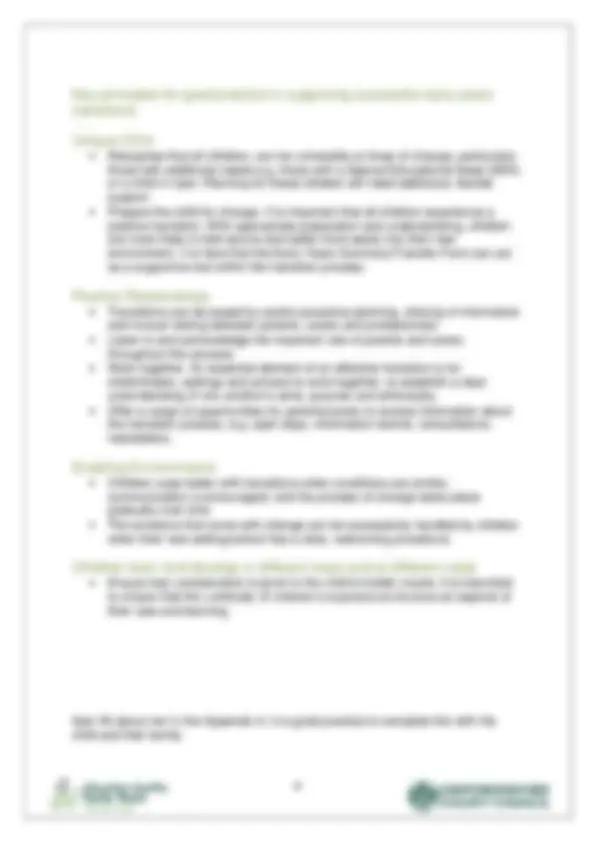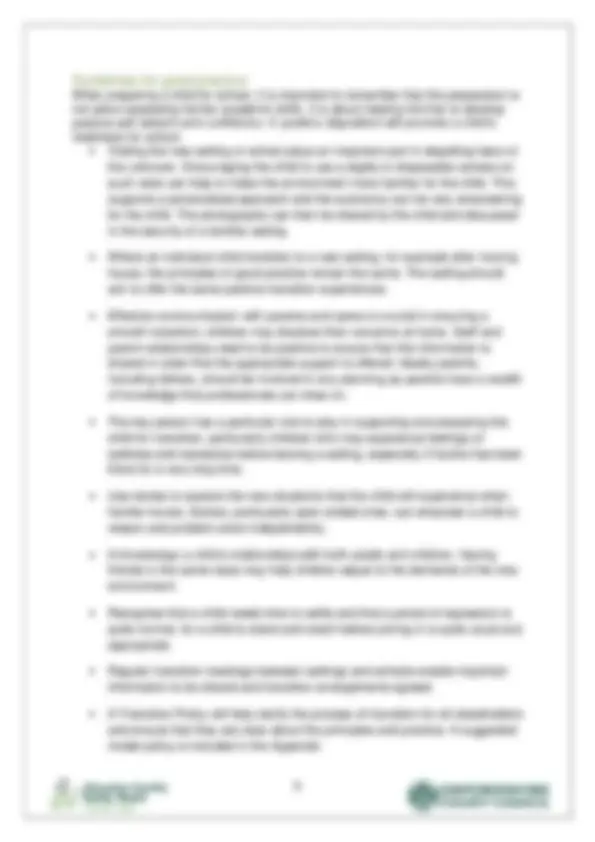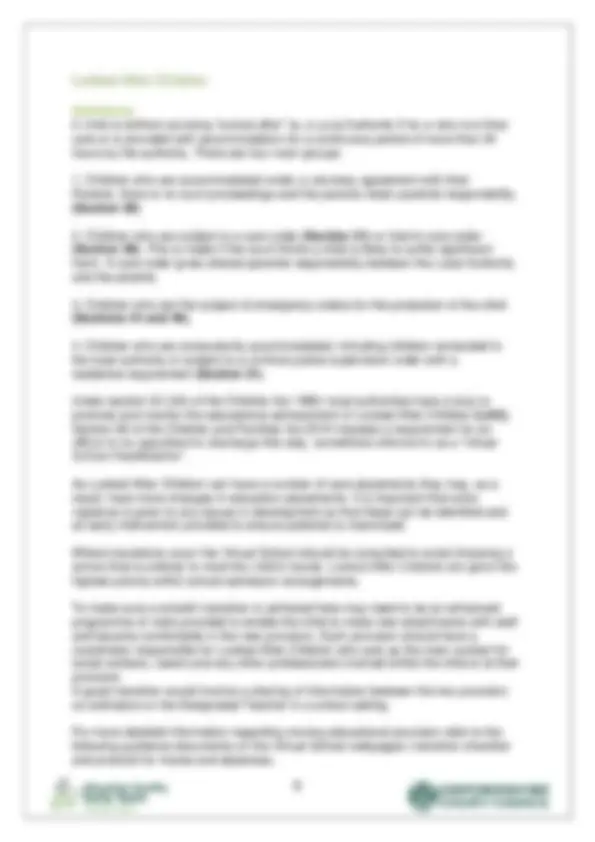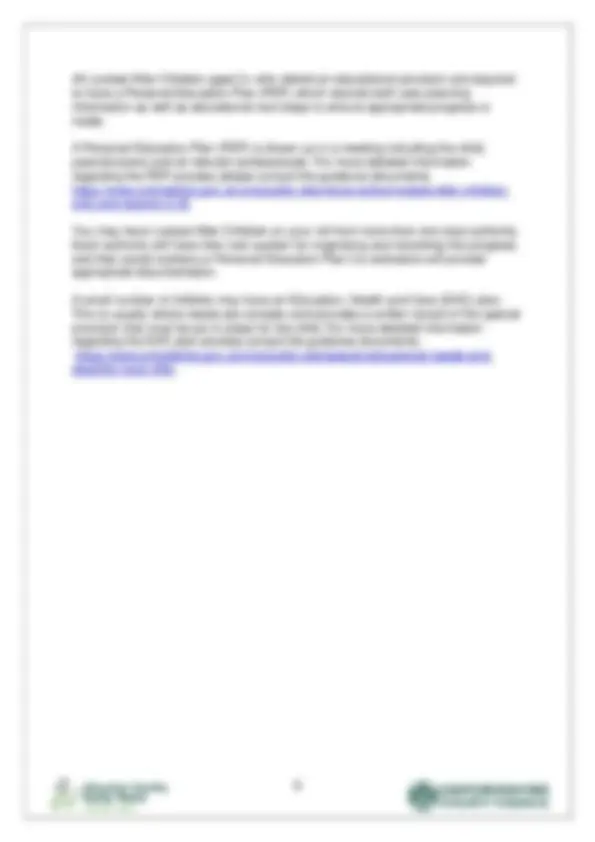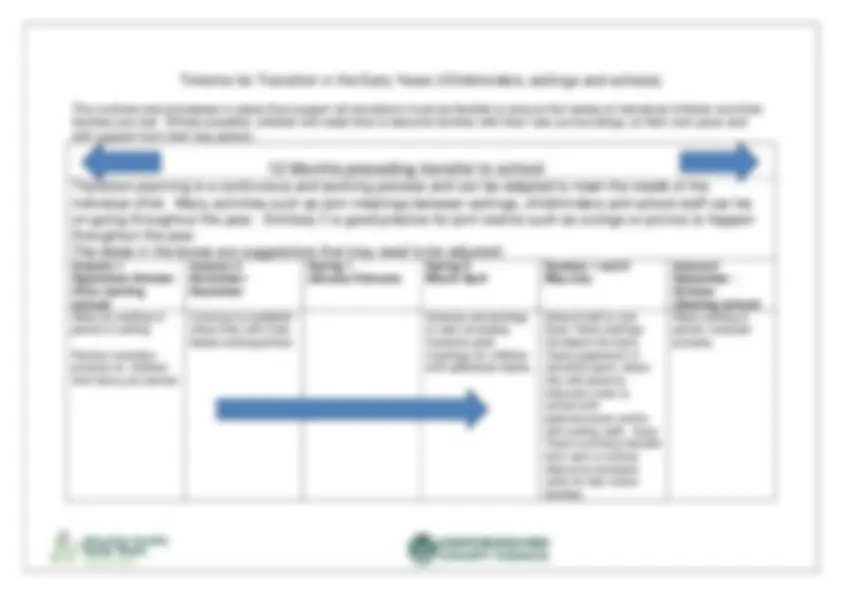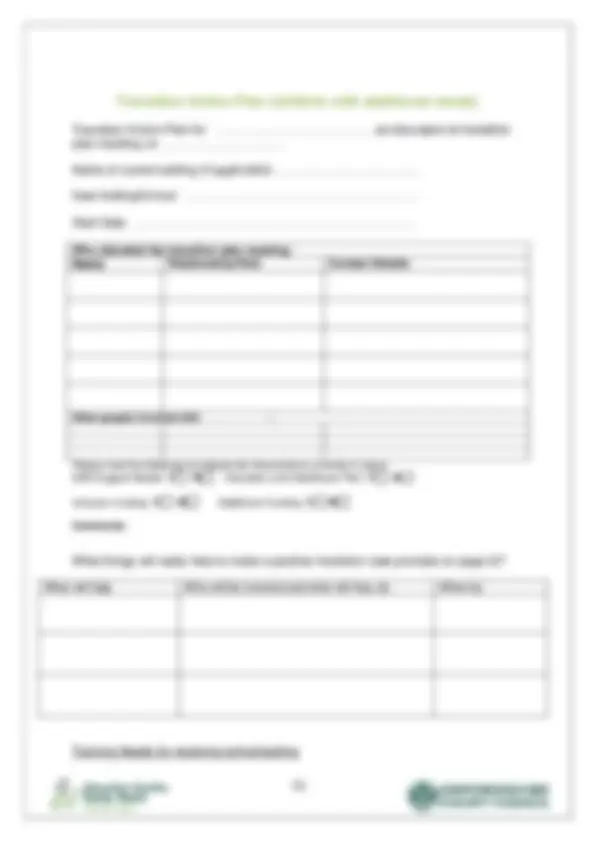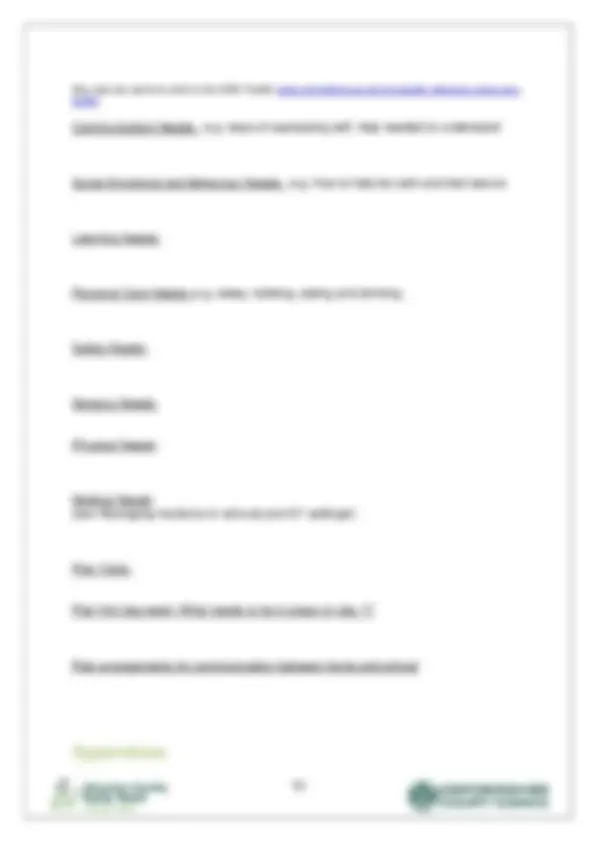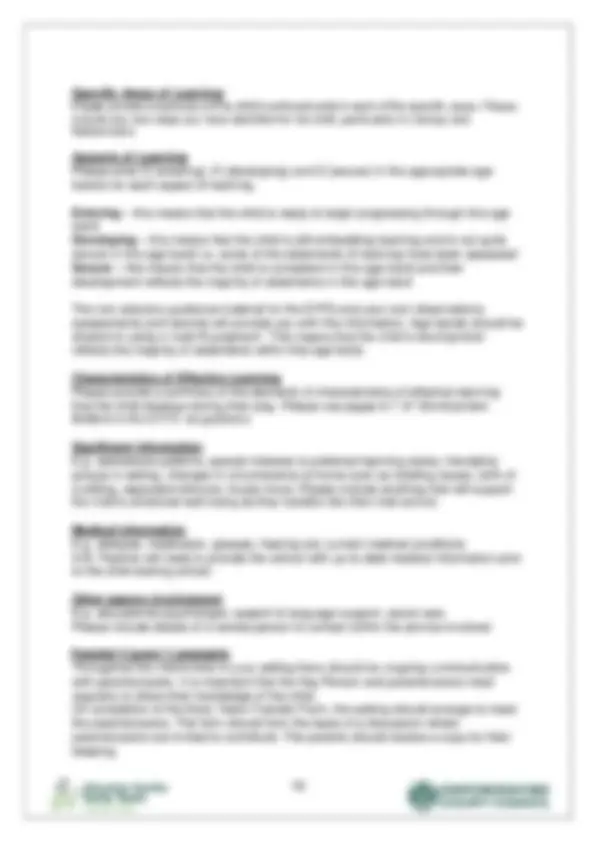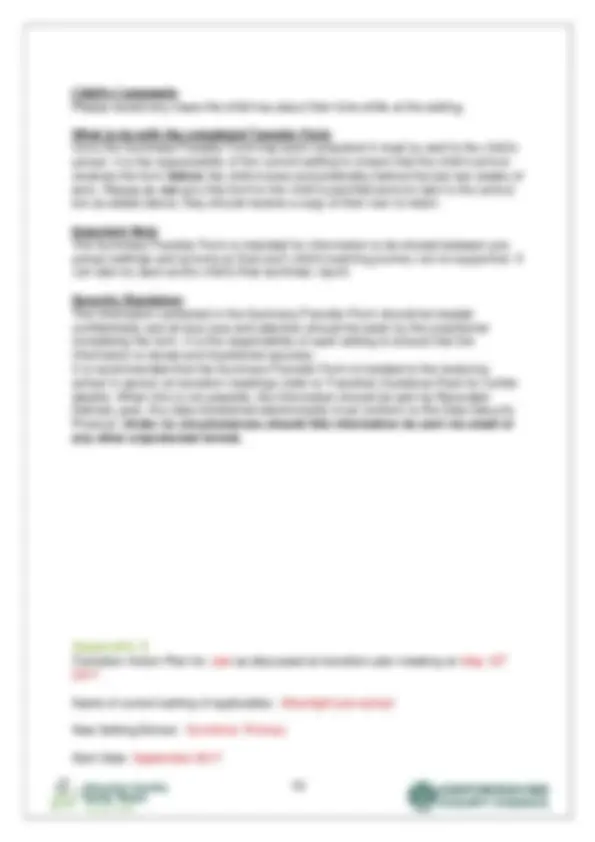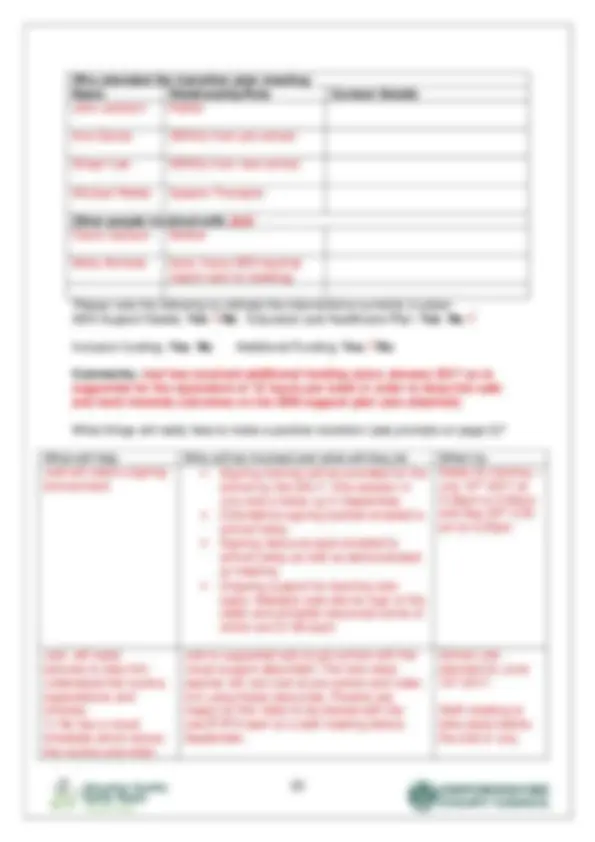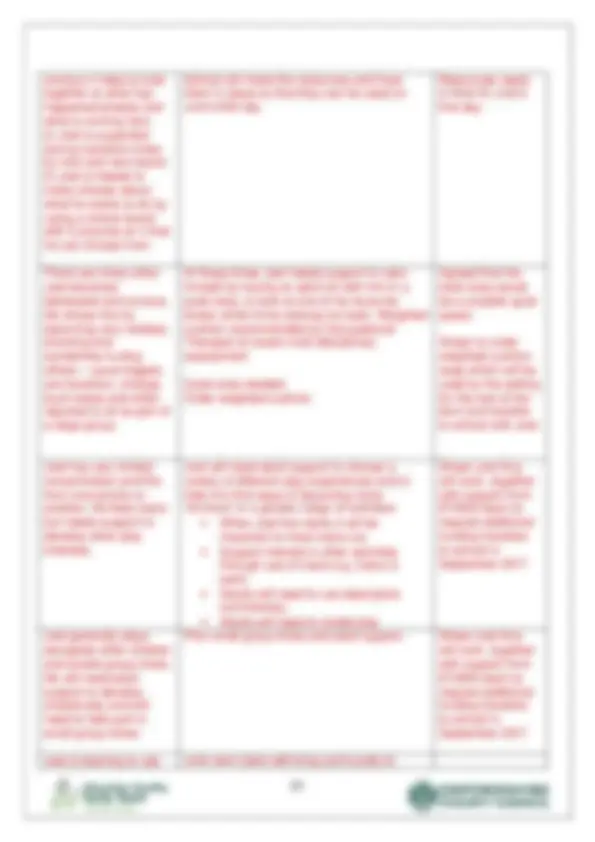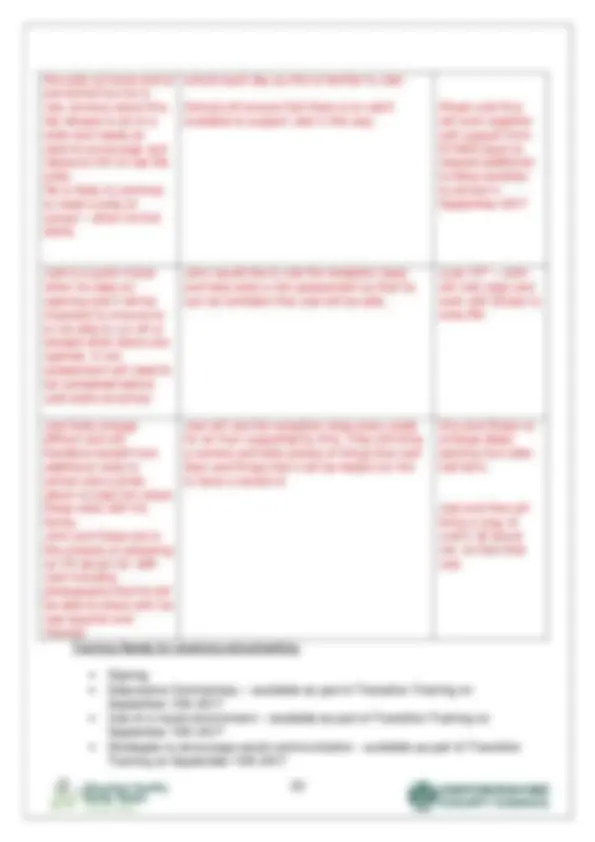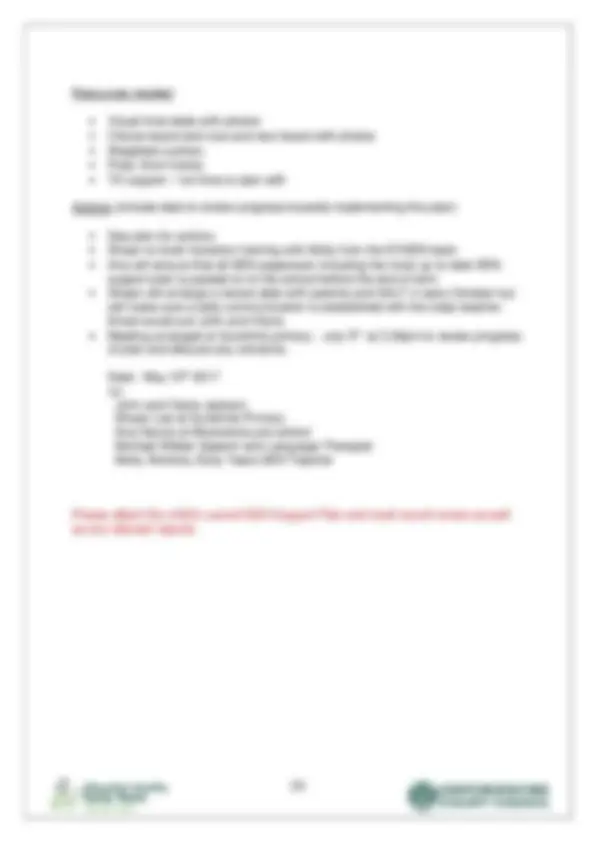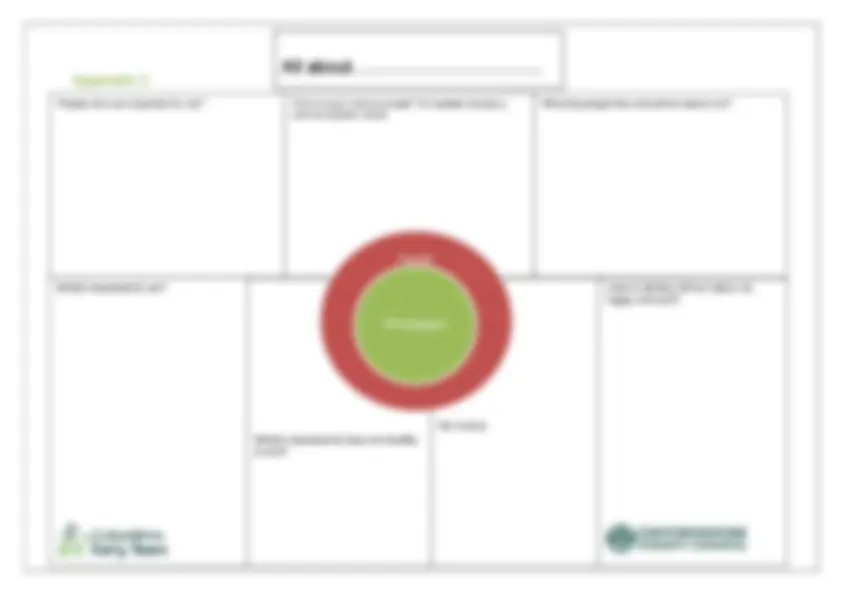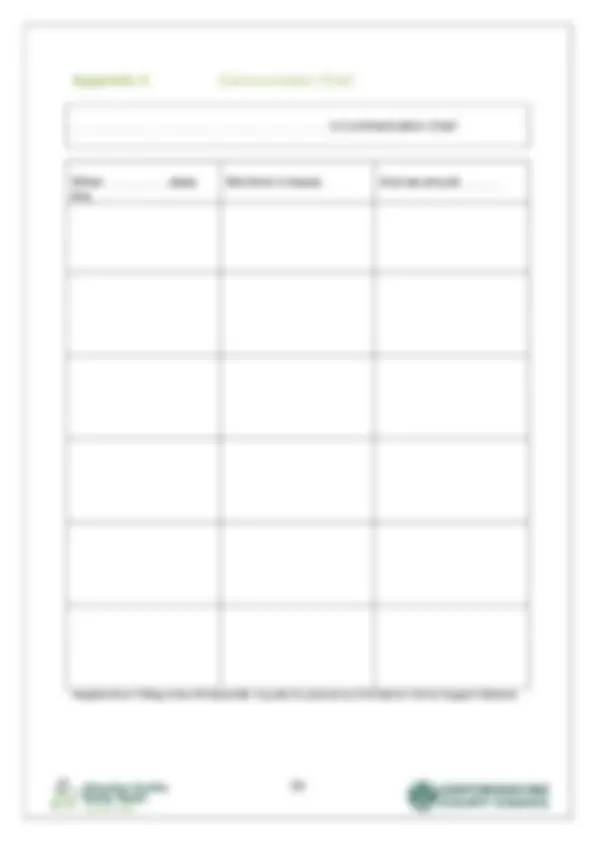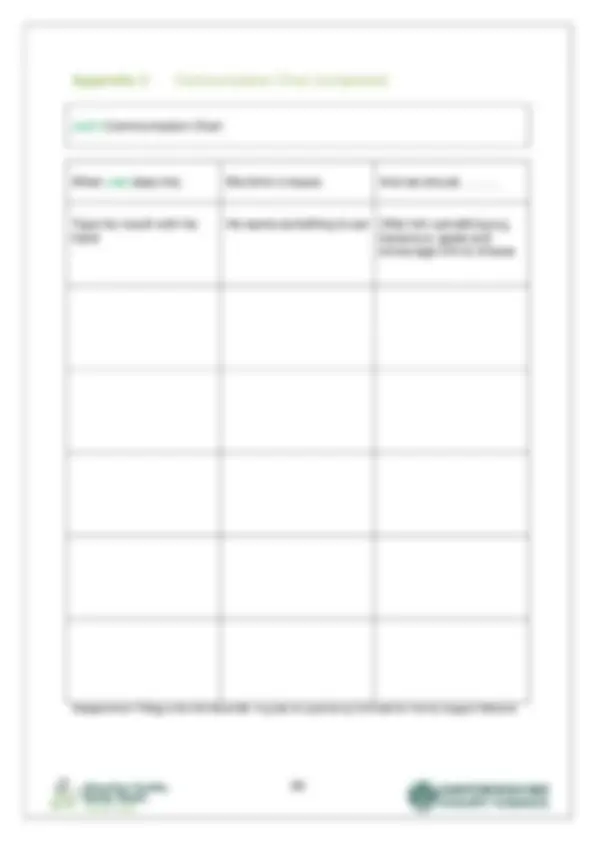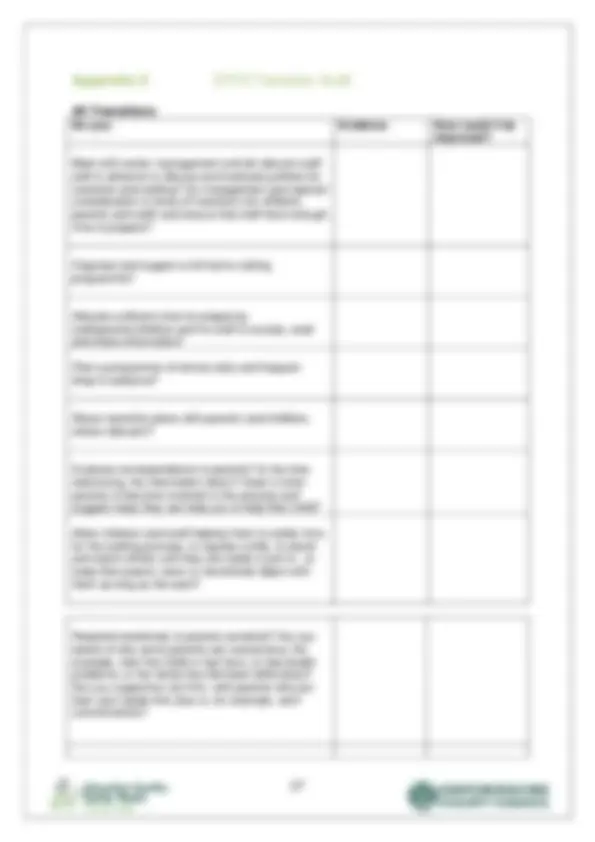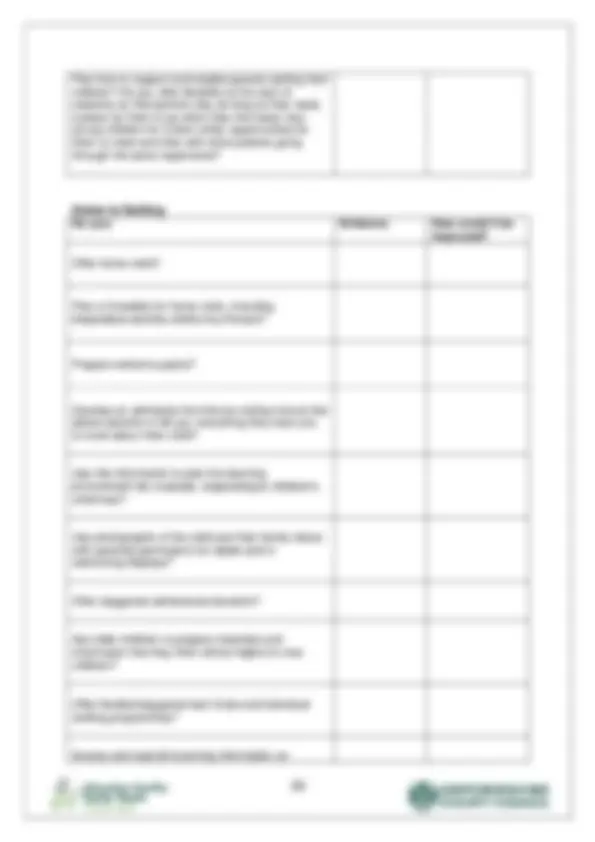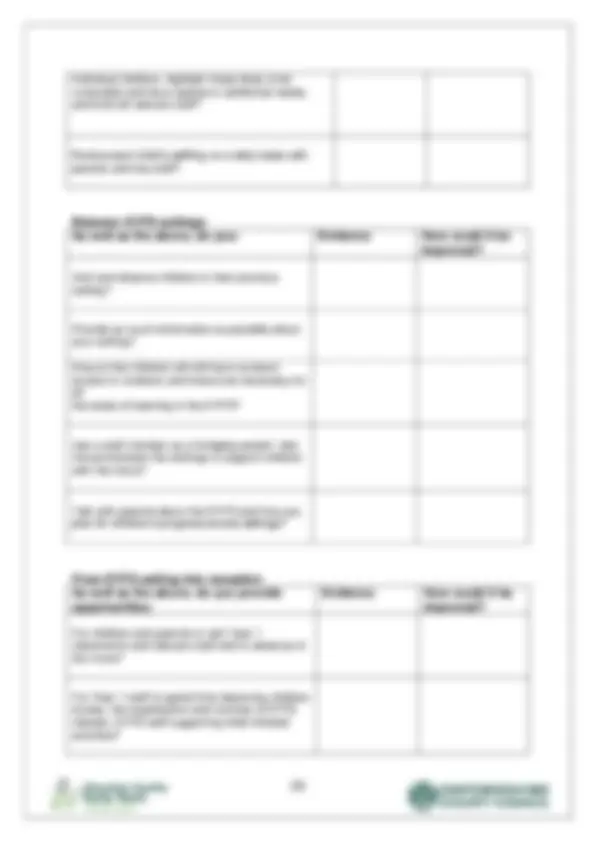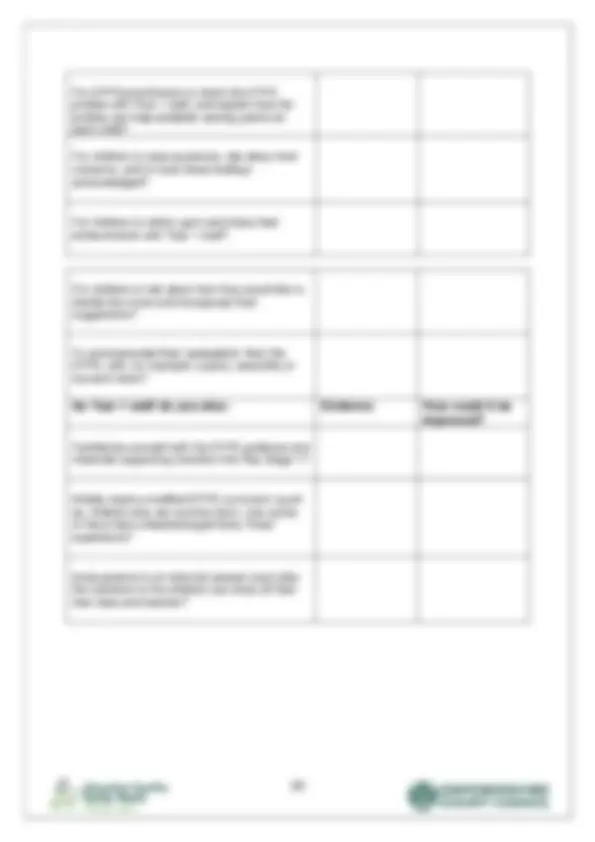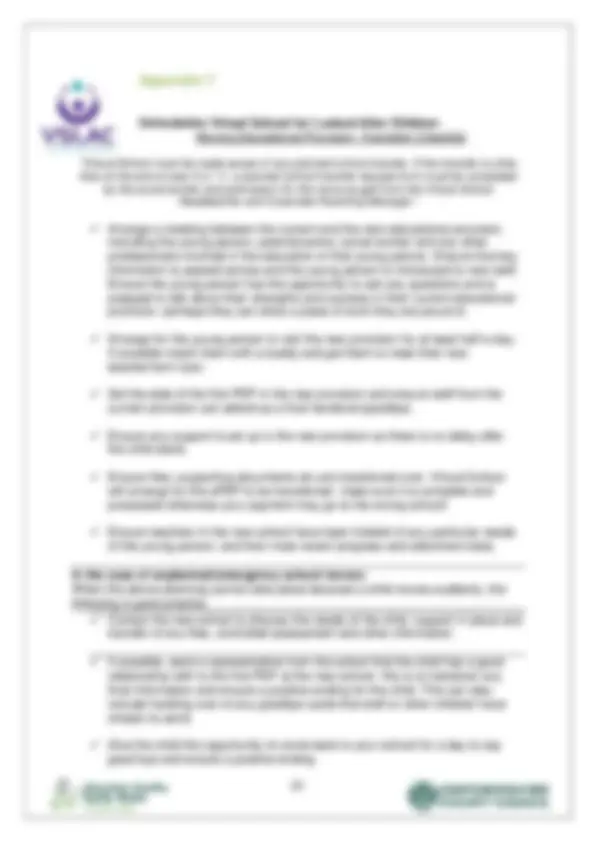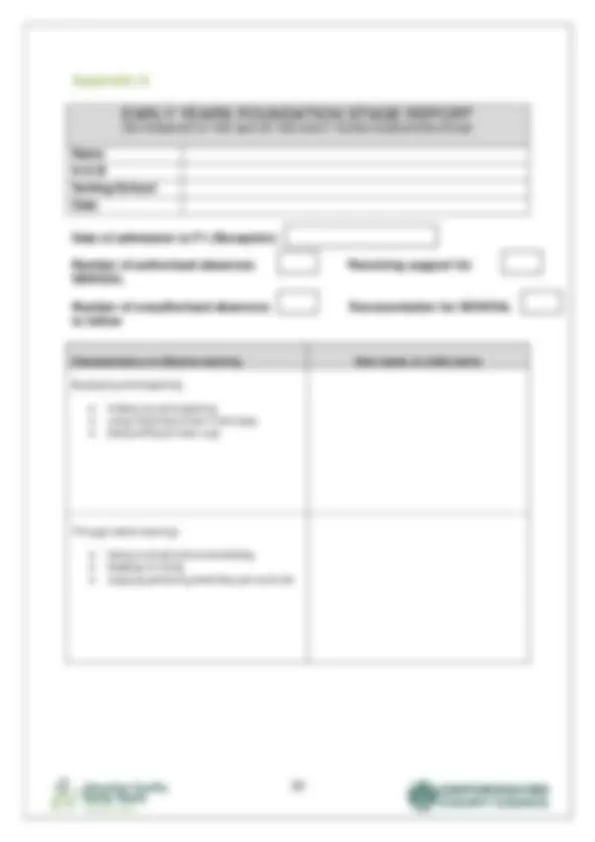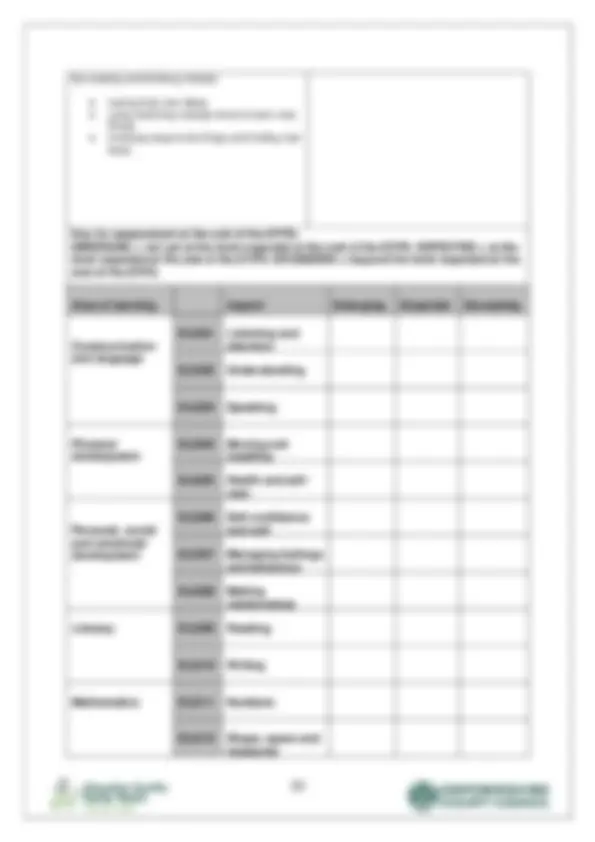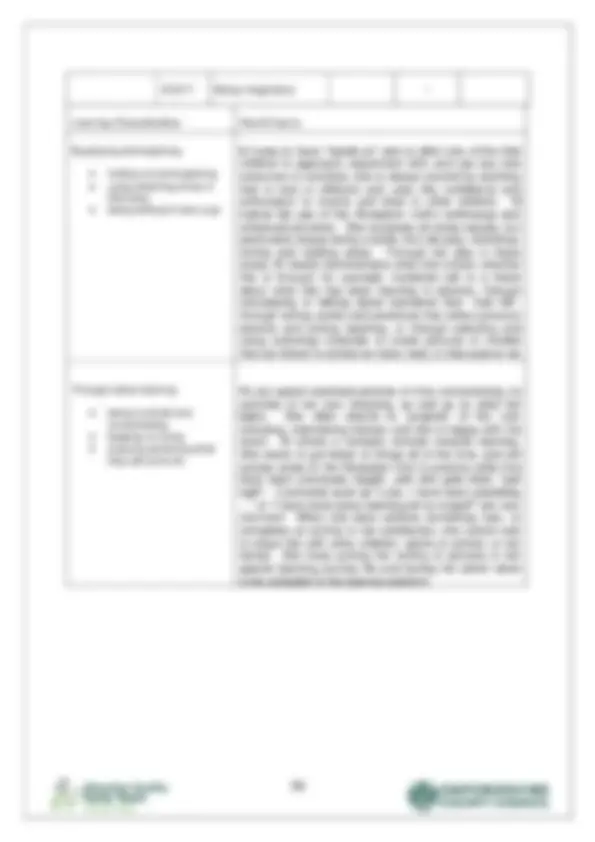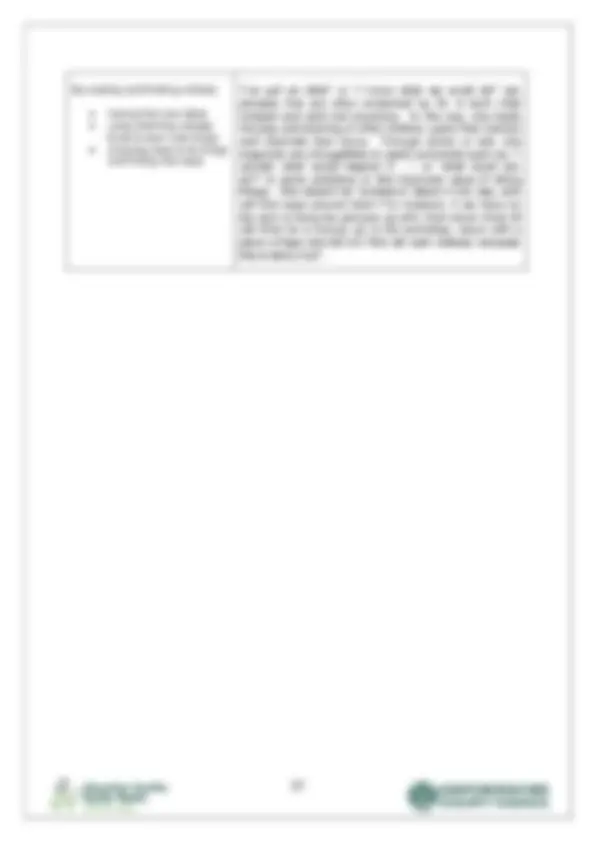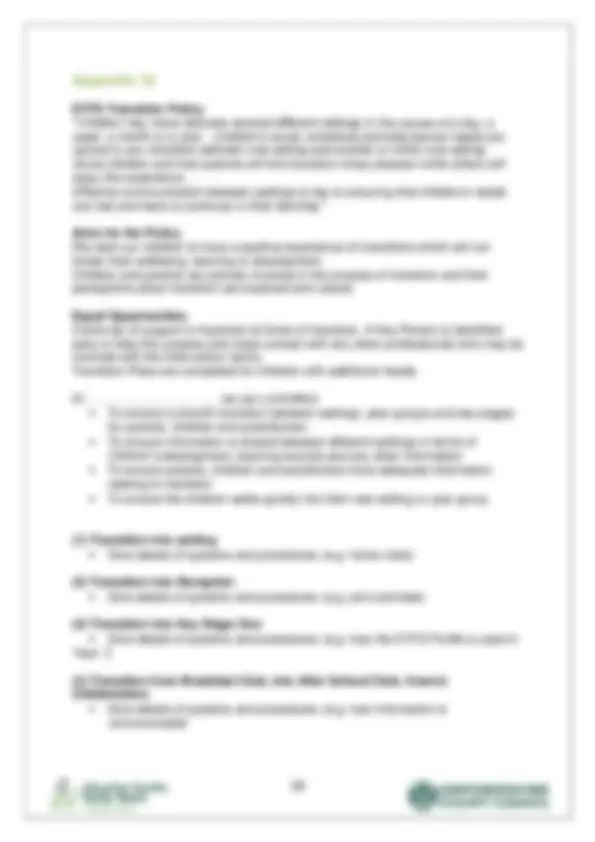Download Guide for Early Years Practitioners: Supporting Transitions for Looked After Children and more Study notes Communication in PDF only on Docsity!
May 2017
Smooth Transitions in the
Early Years: A Good Practice
Guide
Contents
- Introduction
- Key principles for good practice in supporting successful Early Years Transitions
- Guidelines for good practice
- Involving parents and carers in the Transition process
- Children who attend more than one setting
- Children with additional needs
- Looked After Children
- Timelinefor Transition in the Early Years (Childminders, Schools and Settings)
- Oxfordshire Early Years summary/transfer form
- Oxfordshire Early Years summary/transfer form cont
- Transition Action plan (children with additional needs)
- Prompt sheet to help with Transition meeting/making a plan
- Appendices
Key principles for good practice in supporting successful Early Years Transitions
transitions
Unique Child
- Recognise that all children, can be vulnerable at times of change, particularly those with additional needs e.g. those with a Special Educational Need (SEN) or a child in care. Planning for these children will need additional, flexible support.
- Prepare the child for change. It is important that all children experience a positive transition. With appropriate preparation and understanding, children are more likely to feel secure and settle more easily into their new environment. It is here that the Early Years Summary/Transfer Form can act as a supportive tool within the transition process.
Positive Relationships
- Transitions can be eased by careful proactive planning, sharing of information and mutual visiting between parents, carers and professionals.
- Listen to and acknowledge the important role of parents and carers throughout this process
- Work together. An essential element of an effective transition is for childminders, settings and schools to work together, to establish a clear understanding of one another’s aims, purpose and philosophy.
- Offer a range of opportunities for parents/carers to access information about the transition process, e.g. open days, information events, consultations, newsletters.
Enabling Environments
- Children cope better with transitions when conditions are similar, communication is encouraged, and the process of change takes place gradually over time
- The emotions that come with change can be successfully handled by children when their new setting/school has a clear, welcoming procedure.
Children learn and develop in different ways and at different rates
- Ensure that consideration is given to the child’s holistic needs. It is important to ensure that the continuity of children’s experiences involves all aspects of their care and learning See 'All about me' in the Appendix 4; it is good practice to complete this with the child and their family.
Guidelines for good practice
When preparing a child for school, it is important to remember that the preparation is not about assessing his/her academic skills. It is about helping him/her to develop positive self-esteem and confidence. A positive disposition will promote a child’s readiness for school.
- Visiting the new setting or school plays an important part in dispelling fears of the unknown. Encouraging the child to use a digital or disposable camera on such visits can help to make the environment more familiar for the child. This supports a personalised approach and the autonomy can be very empowering for the child. The photographs can then be shared by the child and discussed in the security of a familiar setting.
- Where an individual child transfers to a new setting, for example after moving house, the principles of good practice remain the same. The setting should aim to offer the same positive transition experiences.
- Effective communication with parents and carers is crucial in ensuring a smooth transition; children may disclose their concerns at home. Staff and parent relationships need to be positive to ensure that this information is shared in order that the appropriate support is offered. Ideally parents, including fathers, should be involved in any planning as parents have a wealth of knowledge that professionals can draw on.
- The key person has a particular role to play in supporting and preparing the child for transition; particularly children who may experience feelings of sadness and resistance before leaving a setting, especially if he/she has been there for a very long time.
- Use stories to explore the new situations that the child will experience when he/she moves. Stories, particularly open ended ones, can empower a child to reason and problem solve independently.
- Acknowledge a child’s relationships with both adults and children. Having friends in the same class may help children adjust to the demands of the new environment.
- Recognise that a child needs time to settle and that a period of regression is quite normal, for a child to stand and watch before joining in is quite usual and appropriate.
- Regular transition meetings between settings and schools enable important information to be shared and transition arrangements agreed.
- A Transition Policy will help clarify the process of transition for all stakeholders and ensure that they are clear about the principles and practice. A suggested model policy is included in the Appendix
Children with additional needs
The Special Educational Needs and Disability Code of Practice 2014 says that a child has Special Educational Needs if they have a learning difficulty or disability which calls for special educational provision to be made for him or her. ‘A child of compulsory school age or a young person has a learning difficulty or disability if he or she:
- has a significantly greater difficulty in learning than the majority of others of the same age, or
- has a disability which prevents or hinders him or her from making use of facilities of a kind generally provided for others of the same age in mainstream schools’ Transition should be seen as a process which involves parents/carers, child, setting and receiving setting. (EYFS 2008) A child’s transition from home to a preschool setting or from a setting to school can be an anxious time, particularly if there are additional needs with regard to their development of speech and language and communication, health and physical needs or general development. Periods of change can be made less daunting if parents’ and carers’ views are respected and they feel that they have made a suitable contribution to what will happen when their child moves to a new setting.
- During a child’s time in a preschool setting the setting Special Educational Need Coordinator (SENCo) and the child’s key person will have had regular meetings with parents or carers for discussion and to facilitate liaison with other professionals.
- As preparation for transferring to school a transition meeting for parents with the SENCo at the school and, when appropriate, other professionals supporting the child should be arranged. The transition meeting is a partnership between parents/carers, preschool setting and school.
- Outside agency reports and records such as completed and current SEN Support Plans are an important addition to the Early Years Transfer Record and should be passed to the school or new setting when the child leaves.
- Medical care plans and any relevant adjustments should be discussed at the transition meeting.
- Some children with additional needs may require extra visits to their new school prior to the term before starting. These can be arranged during the transition meeting at the school as well as any additional support such as a new visual schedule or tailored admission plan to ensure a smooth transition. Please refer to the Transition Plan included in the appendix.
Looked After Children
Definitions A child is defined as being “looked after” by a Local Authority if he or she is in their care or is provided with accommodation for a continuous period of more than 24 hours by the authority. There are four main groups:
- Children who are accommodated under a voluntary agreement with their Parents, there is no court proceedings and the parents retain parental responsibility. (Section 20)
- Children who are subject to a care order (Section 31) or interim care order (Section 38). This is made if the court thinks a child is likely to suffer significant harm. A care order gives shared parental responsibility between the Local Authority and the parents.
- Children who are the subject of emergency orders for the protection of the child (Sections 44 and 46).
- Children who are compulsorily accommodated, including children remanded to the local authority or subject to a criminal justice supervision order with a residence requirement (Section 21) Under section 22 (3A) of the Children Act 1989, local authorities have a duty to promote and monitor the educational achievement of Looked After Children (LAC). Section 99 of the Children and Families Act 2014 imposes a requirement for an officer to be appointed to discharge this duty, sometimes referred to as a ‘Virtual School Headteacher’. As Looked After Children can have a number of care placements they may, as a result, have more changes in education placements. It is important that extra vigilance is given to any issues in development so that these can be identified and an early intervention provided to ensure potential is maximised. Where transitions occur the Virtual School should be consulted to avoid choosing a school that is unlikely to meet the child’s needs. Looked After Children are given the highest priority within school admission arrangements. To make sure a smooth transition is achieved here may need to be an enhanced programme of visits provided to enable the child to make new attachments with staff and become comfortable in the new provision. Each provision should have a coordinator responsible for Looked After Children who acts as the main contact for social workers, carers and any other professionals involved whilst the child is at their provision. A good transition would involve a sharing of information between the two provision co-ordinators or the Designated Teacher in a school setting. For more detailed information regarding moving educational provision refer to the following guidance documents on the Virtual School webpages: transition checklist and protocol for moves and absences.
Timelinefor Transition in the Early Years (Childminders, Schools and Settings)
The routines and processes in place that support all transitions must be flexible to ensure the needs of individual children and their families are met. Where possible, children will need time to become familiar with their new surroundings, at their own pace and with support from their key person. 12 Months preceding transfer to school
Transition planning is a continuious and evolving process and can be adapted to meet the needs of the
individual child. Many activities such as joint meetings between settings, childminders and school staff can be
on-going throughout the year. Similarly it is good practice for joint events such as outings or picnics to happen
throughout the year.
The dates in the boxes are suggestions that may need to be adjusted.
Autumn 1 September-October (Prior starting school) Autumn 2 November- December Spring 1 January-February Spring 2 March-April Summer 1 and 2 May-July Autumn September - October (Starting school) Allow for settling in period in setting. Review transition process re: children who have just started. Continue to establish close links with main feeder setting/school. Schools and settings to start arranging transition plan meetings for children with additional needs. School staff to visit Early Years settings. Complete the Early Years paperwork in transition pack; share this with parents. Induction visits to school with parents/carers and/or with setting staff. Early Years summary/transfer form sent to school. Add extra transition visits for late notice families. Allow settling in period, evaluate process.
Oxfordshire Early Years Summary/Transfer Form.
Please refer to the guidance notes when completing this form Child's Full name: M/F UPN if allocated: LAC: Y/N EHA: Y/N Belonging Authority: Name used if different from above: Parental Responsibility: Pupil Premium Y/N Date of progress check at 2 years: Area of concern: Date of Birth: Age in months at time of assessment: Form completed by: Date completed: Name and address of setting/childminder: Date of entry: Date of leaving: Key Person: Contact number: Hours per week: Other settings attended: Does the child have additional needs? Y/N (if yes, please also complete EYFS SEN Transition Plan) Language(s) spoken at home by the child: Language(s) used by family to the child: Transferring to: Current achievements in Prime Areas of Learning: (Key - E=entering D=developing S=secure) Communication and Language Listening and Attention 16 - 26 E D S 22 - 36 E D S 30 - 50 E D S 40 - 60 E D S Understanding 16 - 26 E D S 22 - 36 E D S 30 - 50 E D S 40 - 60 E D S Speaking 16 - 26 E D S 22 - 36 E D S 30 - 50 E D S 40 - 60 E D S Physical Development Moving and handling 16 - 26 E D S 22 - 36 E D S 30 - 50 E D S 40 - 60 E D S Health and self-care 16 - 26 E D S 22 - 36 E D S 30 - 50 E D S 40 - 60 E D S Personal, social and Emotional Development Self-confidence and self- awareness 16 - 26 E D S 22 - 36 E D S 30 - 50 E D S 40 - 60 E D S Managing feelings and behaviour 16 - 26 E D S 22 - 36 E D S 30 - 50 E D S 40 - 60 E D S Current achievements in Specific Areas of learning: ( Key - E=entering D=developing S=secure) Literacy Reading 16 - 26 E D S 22 - 36 E D S 30 - 50 E D S 40 - 60 E D S Writing 16 - 26 E D S 22 - 36 E D S 30 - 50 E D S 40 - 60 E D S Mathematics Numbers 16 - 26 E D S 22 - 36 E D S 30 - 50 E D S 40 - 60 E D S Shape, space and measure 16 - 26 E D S 22 - 36 E D S 30 - 50 E D S 40 - 60 E D S Understanding the world Expressive Arts and Design People and communities 16 - 26 E D S 22 - 36 E D S 30 - 50 E D S 40 - 60 E D S Exploring and using media and materials 16 - 26 E D S 22 - 36 E D S 30 - 50 E D S 40 - 60 E D S The world 16 - 26 E D S 22 - 36 E D S 30 - 50 E D S 40 - 60 E D S Being imaginative 16 - 26 E D S 22 - 36 E D S 30 - 50 E D S 40 - 60 E D S Technology 16 - 26 E D S 22 - 36 E D S 30 - 50 E D S 40 - 60 E D S 16 - 26 E D S 22 - 36 E D S 30 - 50 E D S 40 - 60 E D S Characteristics of Effective Learning: Engagement Motivation Thinking
Transition Action plan (children with additional needs)
Transition Action Plan for .…………………………………as discussed at transition plan meeting on ………………………… Name of current setting (if applicable) ……………………………… New Setting/School …………………………………………………. Start Date …………………………………………………………….. Who attended the transition plan meeting: Name Relationship/Role^ Contact Details Other people involved with : Please note the following to indicate the interventions currently in place: SEN Support Needs: Y N Education and Healthcare Plan: Y N Inclusion funding: Y N Additional Funding: Y N Comments: What things will really help to make a positive transition (see prompts on page 2)? What will help Who will be involved and what will they do When by Training Needs for receiving school/setting
Resources needed Actions (include date to review progress towards implementing this plan) Date: cc: Please attach the child’s current SEN Support Plan and most recent review as well as any relevant reports.
Prompt sheet to help with Transition meeting/making a plan
**1. Oxfordshire Early Years Transfer Form Guidance Notes (pg.18)
- Transition Action Plan example (pg.21)
- All About……..(pg.25)
- Communication chart (pg.26)
- Communication chart - example (pg.27)
- EYFS Transition Audit (pg.28)
- Moving Educational Provision - Transition checklist, VSLAC (pg.32)
- EYFS report on transfer at the end of the Early Years Foundation Stage** **(pg.33)
- EYFS report guidance (pg.36)
- Transition policy (pg.39)**
Appendix 1 - Oxfordshire Early Years Transfer Form Guidance Notes
The Early Years Transfer Form must be completed for all EYFS children moving into school. The observations and assessments that you have already completed for each child will support you with this. The aim of the document is to provide a clear summary of information relating to the child’s
learning and development. It should be completed as part of a transition process and not in isolation. This is to ensure continuity and progression in planning for children’s learning as well as consistency in practice to meet the needs of each individual child. Further guidance regarding good transition practice is contained in the accompanying Transition Guidance Pack. Parental permission must be obtained prior to this information being transferred. Completing the Form Personal Details Please give details of the child and setting in the boxes at the beginning of the form including:
- DOB/Age in months at time of assessment - Please write the child’s date of birth and the child’s age in months.
- EHA - If an Early Help Assessment has been completed for the child, you only need to state ‘yes’. There is no need to include any further information on the form.
- LAC - Indicate whether the child is a Looked After Child (LAC) and which is the Belonging Authority.
- Key Person - Give details of the child’s Key Person at the setting.
- Language(s) spoken at home by child. E.g. the main language(s) the child speaks at home.
- Language(s) used by family to the child. E.g. language(s) spoken by parents and extended family.
- Other settings attended - Give details of any other pre-school, nursery or childminder the child attends.
- Transferring to - Record name of the school the child is expected to attend at the time of this summary.
- Additional needs - E.g. Does the child have additional needs regarding speech & language? Are there behavioural concerns? Is the child on the Special Education Needs (SEN) or Gifted and Talented (G &T) register? If yes, please complete the transition action plan in addition to this summary form.
- Date of Entry/Date of Leaving/Hours per week - Give details of starting and leaving date. Please also give details of how many hours a week, the child is due to attend. Please make further comment in significant information about attendance patterns. Prime Areas of Learning Please provide a summary of the child’s achievements in each of the prime areas including Communication and language, Physical development and Personal, social and emotional development. Please also include any next steps that you have identified for the child.
Child’s Comments Please record any views the child has about their time while at the setting. What to do with the completed Transfer Form Once the Summary/Transfer Form has been completed it must be sent to the child’s school. It is the responsibility of the current setting to ensure that the child’s school receives the form before the child moves and preferably before the last two weeks of term. Please do not give this form to the child’s parents/carers to take to the school but as stated above, they should receive a copy of their own to retain. Important Note The Summary/Transfer Form is intended for information to be shared between pre- school settings and schools so that each child’s learning journey can be supported. It can also be used as the child’s final summary report. Security Disclaimer The information contained in the Summary/Transfer Form should be treated confidentially and all due care and attention should be taken by the practitioner completing the form. It is the responsibility of each setting to ensure that the information is stored and transferred securely. It is recommended that the Summary/Transfer Form is handed to the receiving school in person at transition meetings (refer to Transition Guidance Pack for further details). When this is not possible, the information should be sent by Recorded Delivery post. Any data transferred electronically must conform to the Data Security Protocol. Under no circumstances should this information be sent via email or any other unprotected format.
Appendix 2
Transition Action Plan for Joel as discussed at transition plan meeting on May 10 th 2017 Name of current setting (if applicable) - Moonlight pre-school New Setting/School - Sunshine Primary Start Date September 2017
Who attended the transition plan meeting: Name Relationship/Role Contact Details John Jackson Father Ana Garcia SENCo from pre-school Shaan Lee SENCo from new school Michael Weber Speech Therapist Other people involved with Joel Claire Jackson Mother Molly Akintola Early Years SEN teacher (report sent to meeting) Please note the following to indicate the interventions currently in place: SEN Support Needs: Yes √ No Education and Healthcare Plan: Yes No √ Inclusion funding: Yes No Additional Funding: Yes √ No Comments: Joel has received additional funding since January 2017 so is supported for the equivalent of 15 hours per week in order to keep him safe and work towards outcomes on his SEN support plan (see attached) What things will really help to make a positive transition (see prompts on page 2)? What will help Who will be involved and what will they do When by Joel will need a signing environment
- Signing training will be provided for the school by the SALT. One session in July and a follow up in September.
- Oxfordshire signing booklet emailed to school today
- Signing resource pack emailed to school today as well as demonstrated at meeting.
- Ongoing support for learning new signs: Makaton web site for sign of the week and printable resources some of which are £1.99 each. Dates for training – July 12th^ 2017 at 3.30pm to 5.00pm and Sep 20th^ 3. pm to 5.00pm Joel will need pictures to help him understand the routine, expectations and choices.
- He has a visual timetable which shows the routine and when Joel is supported well at pre-school with the visual support described. The new class teacher will visit Joel at pre-school and video him using these resources. Parents are happy for this video to be shared with the new EYFS team at a staff meeting before September. School visit planned for June 15 th^ 2017. Staff meeting to take place before the end of July.


